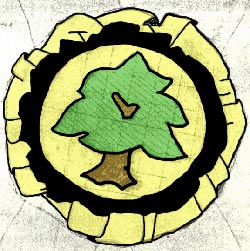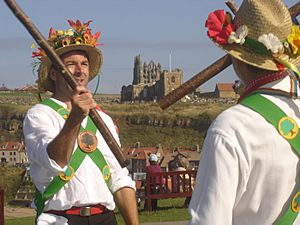Woodside Morris Men facts for kids
Woodside Morris is a dance group from Watford, Hertfordshire, in the UK. They perform a traditional English folk dance called Morris dance. Specifically, they dance the Cotswold morris style. You can often see them dancing in towns and villages near Watford, like Rickmansworth, Hemel Hempstead, and St Albans. They also travel across the country for folk festivals and sometimes even go abroad!
Contents
How Woodside Morris Started
Woodside Morris Men first began in Finchley, North London. Their name comes from a school in an area called Woodside Park. This school was where the Phoenix Folk Club used to meet.
In 1956, after a special dance tour, the Phoenix Folk Club decided to create a dedicated Morris dance group for men. They wanted to focus on Cotswold Morris dancing.
A man named Edmund 'Eddie' Reavell was put in charge of starting this new club. Eddie later became the leader, or "Squire," of the group for a long time. To help get the club going, he got advice from a famous dancer and teacher, Bert Cleaver. Bert became the first Squire.
Under Bert's guidance and Eddie's organization, the club grew. They created special outfits with a tree emblem to match their name. The first official meeting was in September 1956. About a year later, they performed in public for the very first time!
Joining the Morris Ring
From the beginning, Woodside Morris Men wanted to be part of the Morris Ring. This is a big organization for men's Morris dance groups. Their rules and leaders matched what the Morris Ring expected.
Their first public dance was at a Morris Ring event in Kingston upon Thames, London. Two years later, Woodside Morris officially became members of the Morris Ring. Eddie Reavell, who was then the Squire, received their special staff of association.
In their early years, Woodside Morris danced at local community events and often joined Morris Ring meetings. They also took trips to different places, with Deal, Kent being a favorite. They often danced with other London groups like Westminster Morris Men and Hammersmith Morris Men.
Moving to Watford
Originally, Woodside Morris Men were meant to stay part of the Phoenix Folk Club. However, the connection wasn't very strong. In March 1965, the group's leader, Graham Wild, announced a temporary move for practice to the Railway Club in Watford. This temporary move soon became permanent. By July of that year, all their meetings were held at the Railway's social club in Watford.
One of Woodside's members worked for British Rail and was part of their staff association. This helped the group get a good price to use a room at the Railway Club for their Wednesday evening practices.
As the group moved their practices to Watford, they also started holding other events, like feasts and dance days, in the surrounding towns and villages.
Woodside Morris continued to be very active in the Morris Ring. The countryside around Watford was perfect for hosting other dance teams. Moving away from London meant less competition from the many dance groups there. Woodside started getting involved in local community events, even dancing at the Watford Town Hall. Even with their new home, they still danced in some of their old favorite spots in London.
Finding a New Home
In 1969, Woodside Morris faced a small problem. The Railway Club found out that the member who helped them get a good rate no longer worked for British Rail. So, Woodside Morris Men suddenly didn't have a place to practice.
They tried a few temporary places. By the end of 1969, they found a new long-term home at Chater School, Watford.
Later, the group moved again to the Red Lion in Nash Mills, near Hemel Hempstead. During this time, fewer people were joining the group. This meant less money, which usually came from members, donations at dances, and performance fees. It became hard to keep the group going, and they didn't even meet for the whole year of 1973.
During this tough time, a dedicated dancer named Mike 'Lank' Broughton kept the group alive. Lank had many years of dance experience. He had even seen a famous dancer named William Kimber perform. Lank joined Woodside when they moved to Watford. If it weren't for him, Woodside's history might have ended around 1972.
Lank worked hard to find a solution. Even though the group didn't meet in 1973, he was busy planning.
The Pump House Theatre and Arts Centre
In the early 1970s, old Water Board buildings in Watford were fixed up and became a local center for arts groups. This place became known as the Pump House Theatre and Arts Centre. The Watford Folk Club was very important in developing this center.
Woodside Morris became interested and got involved. This created a link not only with the Pump House, where they still meet today, but also with the Folk Club. This new venue seemed promising and also brought many new dancers to the group.
Lank worked hard to get Woodside a spot at the Pump House. He talked to the committee for a whole year to let Woodside use a room on Wednesday nights. Finally, they got a place, though it was smaller than their current room. The agreement was that the dance group would be connected with the folk club.
The new members brought a slightly different approach to where and how often they danced. While dancing at pubs was never a problem for Woodside Morris Men, it now became their main way to perform. They still did tours, Morris Ring meetings, and special dance days, but pub evenings became a regular way to dance and show off Woodside in the local area.



